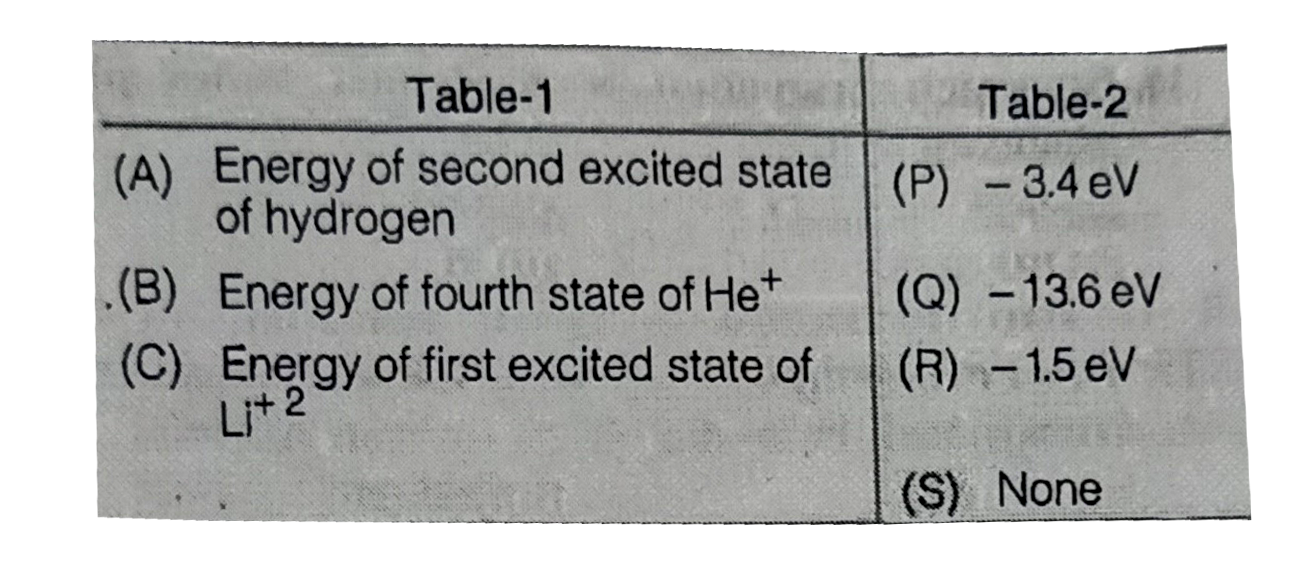The ionisation energy of hydrogen is 13.6 eV . The energy of the photon released when an electron jumps from the first excited state (n=2) to the ground state of hydrogen atom is
3.4 eV
4.53 eV
10.2 eV
13.6eV
The correct Answer is:C
To find the energy of the photon released when an electron jumps from the first excited state (n=2) to the ground state (n=1) of a hydrogen atom, we can follow these steps:
Step 1: Understand the Energy Levels
The energy of an electron in a hydrogen atom at a given principal quantum number n is given by the formula:
En=−13.6eVn2
where En is the energy at the level n and 13.6eV is the ionization energy of hydrogen.
Step 2: Calculate the Energy at n=2
For the first excited state (n=2):
E2=−13.6eV22=−13.6eV4=−3.4eV
Step 3: Calculate the Energy at n=1
For the ground state (n=1):
E1=−13.6eV12=−13.6eV
Step 4: Calculate the Energy of the Photon Released
The energy of the photon released during the transition from n=2 to n=1 is the difference in energy between these two states:
Ephoton=E1−E2
Substituting the values we calculated:
Ephoton=(−13.6eV)−(−3.4eV)=−13.6eV+3.4eV=−10.2eV
Since we are interested in the magnitude of the energy released, we take the positive value:
Ephoton=10.2eV
Final Answer
The energy of the photon released when an electron jumps from the first excited state (n=2) to the ground state (n=1) of a hydrogen atom is 10.2 eV.
---
The energy of an electron in a hydrogen atom at a given principal quantum number n is given by the formula:
En=−13.6eVn2
where En is the energy at the level n and 13.6eV is the ionization energy of hydrogen.
For the first excited state (n=2):
E2=−13.6eV22=−13.6eV4=−3.4eV
For the ground state (n=1):
E1=−13.6eV12=−13.6eV
The energy of the photon released during the transition from n=2 to n=1 is the difference in energy between these two states:
Ephoton=E1−E2
Substituting the values we calculated:
Ephoton=(−13.6eV)−(−3.4eV)=−13.6eV+3.4eV=−10.2eV
Since we are interested in the magnitude of the energy released, we take the positive value:
Ephoton=10.2eV
The energy of the photon released when an electron jumps from the first excited state (n=2) to the ground state (n=1) of a hydrogen atom is 10.2 eV.
Topper's Solved these Questions
Similar Questions
The ionization energy of a hydrogen like bohr atom is 4 Rydbergs (i) What is the wavelength of the radiation emitted when the electron jumps from the first excited state to the ground state ?(ii) what is the radius of the orbit for this atom ?
View SolutionExcitations energy of hydrogen atom is 13.6eV match the following
 View Solution
View Solution
Knowledge Check
- Question 1 - Select One
Energy E of a hydrogen atom with principle quantum number n is given by E=−13.6n2eV. The energy of a photon ejected when the electron jumps from n=3 state to n=2 state of hydrogen is approximately
A1.5eVB0.85eVC3.4eVD1.9eV - Question 2 - Select One
the energy required to excite an electron in hydrogen atom to its first excited state is
A8.5eVB10.2eVC12.7eVD13.6eV
If the binding energy of the electron in a hydrogen atom is 13.6eV, the energy required to remove the electron from the first excited state of Li++ is
View SolutionThe ionisation potential of hydrogen atom is 13.6eV. The energy required to remove an electron in the n=2 state of the hydrogen atom is
View SolutionThe ground state energy of hydrogen atom is −13.6eV. The energy of second excited state of He+ ion in eV is
View SolutionThe ground state energy of hydrogen atom is −13.6eV. What is the potential energy of the electron in this state
View SolutionEnergy E of a hydrogen atom with principle quantum number n is given by E=−13.6n2eV. The energy of a photon ejected when the electron jumps from n=3 state to n=2 state of hydrogen is approximately
View SolutionThe ionisation potential of hydrogen atom is 13.6eV The energy required to remve as electron in the n=2 state of the hydrogen atom is
View Solution

